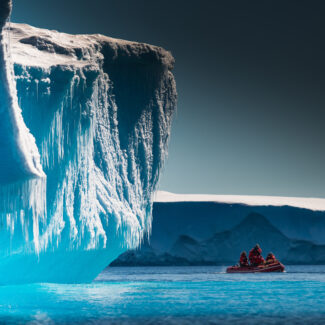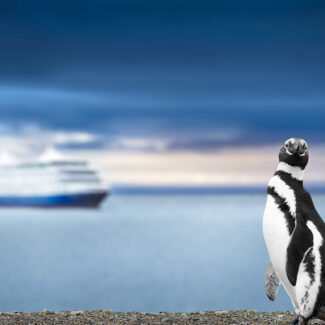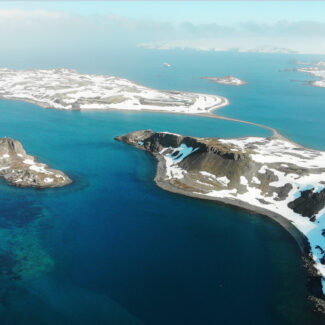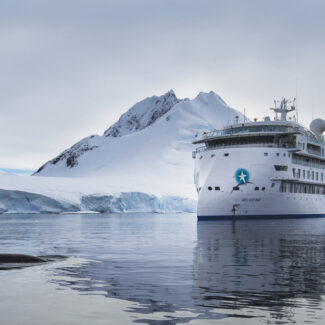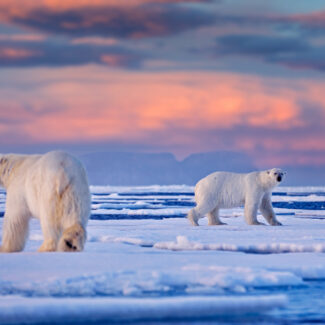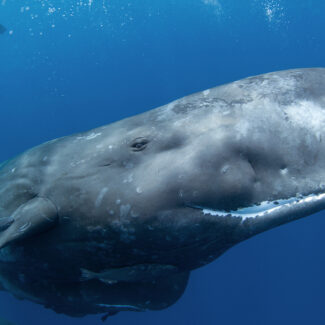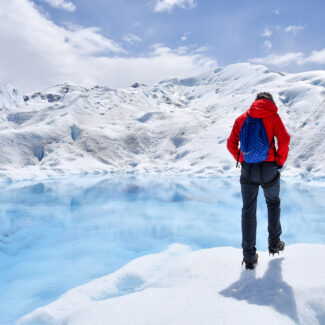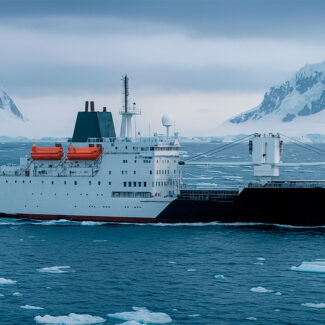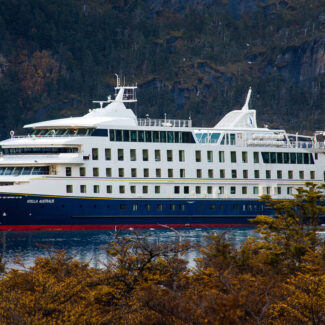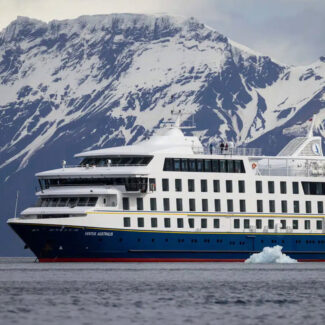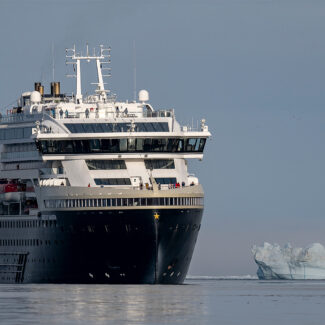The 5 Most Famous Polar Explorers—Of Both Poles—Of All Time
From Admiral Fabian Gottlieg Thaddeus von Bellingshausen to Sir Robert Falcon Scott to Naomi Uemura, there are many legendary names associated with polar exploration and discovery. But only a minority of intrepid adventurers have journeyed to both the northern and southern polar realms, which together rank among the most remote and forbidding places on Earth.
Part of that is obviously the historical difficulty and expense of venturing into the teeth of the polar wildernesses. Another reason, perhaps, is the disinclination of some explorers to follow in the footsteps of those who accomplished a particular feat first—and the increasing challenge of pioneering a novel route or kind of expedition after centuries of polar exploits.
The following five are among the most famous polar explorers in that rarefied club of those who traveled to both the top and the bottom of the globe.
(1) James Cook (1728-1779)
The famed navigator James Cook of the British Royal Navy made seafaring voyages of an almost unbelievable extent in the 1760s and 1770s, and they included some remarkably deep forays into both the Arctic and the Antarctic.
On his second transoceanic voyage, conducted in the HMS Resolution and Adventure, Cook and his men became the first people known to cross the Antarctic Circle, on January 17, 1773. Circumnavigating the huge and roiled Southern Ocean for the first time, Cook would cross the Circle twice more, and in 1774 penetrate farther south than any before him: to 71 degrees 10’ S.
Turned back by heavy sea ice, Cook postulated about the existence of “a tract of land near the [South] Pole, which is the source of most of the ice which is spread over this vast Southern Ocean.” This expedition—which also mapped extensive portions of Australia and New Zealand, made the first known landfall on South Georgia, and documented part of a sub-Antarctic archipelago Cook named the South Sandwich Islands—helped disprove the theory of a Terra Australis Incognita, a huge Southern Hemisphere continent “balancing out” the landmasses of the Northern Hemisphere.
Several years later, Cook sailed to the Pacific coast of North America in an attempt to identify a Northwest Passage connecting to the Atlantic Ocean. In August 1778, Cook traveled from the Bering Strait into the Arctic Ocean, hugging the Beaufort Sea coast of northern Alaska before being turned back (near the present-day village of Wainwright) by pack ice. He followed the pack westward all the way to Siberia, unable to find a way to penetrate farther north.
This northernmost foray of Cook was part of his third and final great voyage; he was killed in the Hawaiian Islands on February 14, 1779.
Behold the meticulous navigator! Sir James Cook, though more renowned for his Pacific voyages, made significant early contributions to Antarctic exploration, setting the stage for those who would later brave the icy south.
Source: Nathaniel Dance-Holland, Public domain, via Wikimedia Commons
(2) James Clark Ross (1800–1862)
The nephew of the accomplished polar explorer Sir John Ross, James Clark Ross accompanied his uncle on a number of Arctic expeditions beginning with an 1818 quest for the Northwest Passage aboard the Isabella and Alexander, a voyage on which William Edward Parry served as second-in-command. The younger Ross then served on a number of Parry-led Arctic trips, including three expeditions (in 1819-1820, 1821-1823, and 1824-1825) seeking the Northwest Passage and an 1827 attempt to reach the North Pole. Serving as midshipman and later second-in-command on these voyages, Ross devoted much of his energy to collecting scientific observations of all kinds.
In 1829, James Clark Ross was once again part of an expedition (this one privately organized) led by his uncle. It was on this four-year Arctic odyssey that he ascertained the location of the North Magnetic Pole.
By this point, James Clark Ross ranked among England’s preeminent Arctic explorers, having spent numerous summers and winters in the polar reaches. With his extensive exploration experience and scientific expertise, he was a natural choice to command an 1839 expedition to the Antarctic: a multi-year undertaking that saw Ross document numerous major and previously uncharted geographies, including what became known as the Ross Sea and the Ross Ice Shelf: the formidable “Barrier” that served as both an obstacle and a portal for later adventurers aiming for the South Pole. After this journey, Ross was knighted and penned a seminal early treatise on the Antarctic: A Voyage of Discovery & Research in the Southern & Antarctic Regions During the Years 1839-43.
In 1848, Ross was once again mustered for an Arctic voyage: this the first search expedition mounted after the lost 1845 expedition of Sir John Franklin, which had vanished on an attempt to traverse the Northwest Passage. Ross’s search party overwintered in the Canadian Arctic Archipelago but failed to find evidence as to the Franklin Expedition’s fate.
Numerous polar and subpolar features honor Sir James Clark Ross. Besides the Ross Sea and Ross Ice Shelf, Antarctica includes Ross Island and the Ross Dependency, for example. The high point of the Kerguelen Islands, a sub-Antarctic archipelago, is 6,070-foot (1,850-meter) Mont Ross. On the other side of the world, Arctic landmarks named after Ross include the James Ross Strait (named by Parry on their 1819-1820 expedition), Ross Bay, Ross Point, and Rossøya.
A scientific milestone etched in the Arctic! This illustration commemorates James Clark Ross’s historic 1831 expedition, the first to successfully reach the North Magnetic Pole, a crucial moment in understanding our planet’s forces.
Source: Huish, Robert (25 September 1776 – April 1850), Public domain, via Wikimedia Commons
(3) Roald Amundsen (1872–1928)
The Norwegian explorer Roald Amundsen is arguably the single most legendary polar adventurer. On the 1903-1906 Gøja voyage, he and a small team accomplished the first successful transit of the Northwest Passage: a prize that had seized the imagination of merchants, explorers, and global powers for centuries. On December 14, 1911, he and his party became the first people to reach the South Pole, famously beating Sir Robert Falcon Scott’s Terra Nova Expedition.
Amundsen and the rest of the Maud Expedition became the third group to navigate the Northeast Passage through the Eurasian Arctic in July 1920—with Amundsen and another expedition member, Helmer Hanssen, thereby earning distinction as the first people to have traversed both the Northwest Passage and the Northeast Passage.
Amundsen had also long dreamed of reaching the North Pole: His Fram expedition to the South Pole had actually originally been aimed at the opposite side of the world, but Amundsen changed his plans in 1909 after learning of Frederick Cook’s and Robert Peary’s (soon much-disputed) claims of attaining the North Pole. A goal of the Maud Expedition, unrealized, was to drift the expedition ship over the North Pole via the sea ice. That scratched effort prompted Amundsen to concentrate on trying to fly there.
After a couple of unsuccessful efforts, Amundsen and more than a dozen others, including the Italian pilot Umberto Nobile, made the first unquestioned flyover of the North Pole in the semi-rigid airship Norge on May 12, 1926. He thus became the first person to reach both the North and South poles.
Two years later, Amundsen disappeared aboard a flying boat that had taken off in an attempt to rescue the survivors of Nobile’s Italia airship, which had crashed on the sea ice more than 100 miles northeast of Spitsbergen after an aerial visit to the North Pole.
The master strategist at work! Here’s Roald Amundsen in his element, planning his groundbreaking polar expeditions from his Uranienborg office – a glimpse into the meticulous mind of a true pioneer.
Source: Anders Beer Wilse/National Library of Norway, Public domain, via Wikimedia Commons
(4) Richard Byrd (1888–1957)
Rear Admiral Richard Byrd of the U.S. Navy is another iconic figure of polar exploration. On May 9, 1926, Byrd and a companion, Floyd Bennett, claimed to fly over the North Pole in the Josephine Ford. This would give the two of them credit for the first flight to the Pole, mere days before Amundsen and the Norge flew over. But Byrd and Bennett’s account has long faced major skepticism—the flight records and Byrd’s own diary, released in the mid-1990s, raise questions as to whether the plane could possibly have gone as far as the North Pole—and is by no means widely accepted.
What is inarguable are the contributions Byrd made to knowledge about the Antarctic, to which he led numerous expeditions beginning in 1928. That first trip, which established the inaugural version of the “Little America” base on the Ross Ice Shelf, saw Byrd complete the first flight to the South Pole: a 19-hour there-and-back at the end of November 1929.
On his second expedition (1933-1935), Byrd nearly perished from acute carbon-monoxide poisoning. He directed the 1939-1941 United States Antarctic Service Expedition commissioned by President Franklin D. Roosevelt. And on Byrd’s 1946-1947 Operation Highjump, vast tracts of Antarctica were mapped for the first time thanks to extensive aerial photography and observations.
Byrd’s last trip to Antarctica came with his role in the first Operation Deep Freeze launched in 1955. He made a final flyover of the South Pole on January 8, 1956.
Wings over the ice! Richard Byrd pioneered the use of aircraft in Antarctic exploration, as seen here with his Fokker Universal, revolutionizing how we reached and understood the frozen south.
Source: Byrd Antarctic Expedition, Public domain, via Wikimedia Commons
(5) Ranulph Fiennes (1944– )
Labeled by the Guinness Book of World Records as “the world’s greatest living explorer,” Englishman Ranulph Fiennes lays claim to a superlative tally of adventures, some of the greatest of which have taken place in the polar latitudes.
He led the 1979-1982 Transglobe Expedition that circumnavigated Earth by its two geographic poles, an unprecedented undertaking summoning comparisons to the “golden age” of exploration. Facing perilous fields of sastrugi and crevasses in Antarctica, the team made it to the South Pole on December 15th, 1980 (and, as Fiennes noted, beat the U.S. scientists at the Amundsen-Scott South Pole Station in “the first ever game of cricket to be played at the South Pole”).
The following year, the Transglobe Expedition forayed by a Boston Whaler and on foot through the Northwest Passage, then embarked by sled for the North Pole, which was reached on April 10, 1982. Fiennes wrote that he found the ever-shifting sea ice of the Arctic more unnerving than the continental ice sheet of Antarctica (a far colder and windier realm than the Arctic, but comparatively stable).
Fiennes and the American nutritionist Mike Stroud became the first to cross the Antarctic continent unsupported in 1993: another remarkable achievement. In 2000, Fiennes attempted a solo unsupported sled trek to the North Pole, but had to abort the expedition after developing dangerous frostbite on his left hand.
Reaching the ultimate southern frontier! This is the Amundsen-Scott South Pole Station, the destination for Ranulph Fiennes’s epic Transglobe Expedition, a testament to his unwavering determination to conquer both poles.
Source: Lynn Teo Simarski / National Science Foundation, Public domain, via Wikimedia Commons
Some Honorable Mentions
While she may not be quite so famous as the above names, the American Ann Bancroft—still leading an adventurous and inspiring life—can hold her polar achievements up to any of them, without question. She became the first woman to reach the North Pole over-ice in a 1986 expedition led by fellow Minnesotan Will Steger.
In the span of 1992 to 1993, she led the first east-west all-woman ski crossing of Greenland as well as the first all-woman ski trek to the South Pole, an expedition that also made her the first woman to reach both geographic poles. The accolades continued in 2001, when Bancroft and the Norwegian adventurer Liv Arnesen became the first women to cross the Antarctic continent.
Speaking of Norwegians, another honorable mention should also go to Børge Ousland, who together with compatriot Erling Kagge, made the first unsupported ski trip to the North Pole via Ellesmere Island in 1990, and four years later accomplished a solo, unsupported trip to the North Pole. In 1996-1997, Ousland then achieved the first solo unsupported trans-Antarctic crossing, and in 2006 he and Mike Horn made the first successful unsupported winter trip to the North Pole.
Will You Join The Pioneering Polar Elite?
Contemporary expedition cruises make conquering both polar realms wonderfully achievable, but relatively few modern-day explorers can claim to have achieved such a remarkable feat and be mentioned in the same breath as the most famous of polar explorers above. Will you become one of them? With Antarctica Cruises, joining the polar elite is possible with our curated portfolio of the very best Arctic and Antarctic voyages.
Disclaimer
Our travel guides are for informational purposes only. While we aim to provide accurate and up-to-date information, Antarctica Cruises makes no representations as to the accuracy or completeness of any information in our guides or found by following any link on this site.
Antarctica Cruises cannot and will not accept responsibility for any omissions or inaccuracies, or for any consequences arising therefrom, including any losses, injuries, or damages resulting from the display or use of this information.


